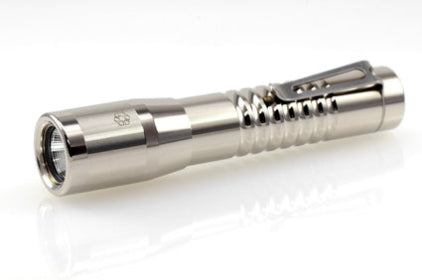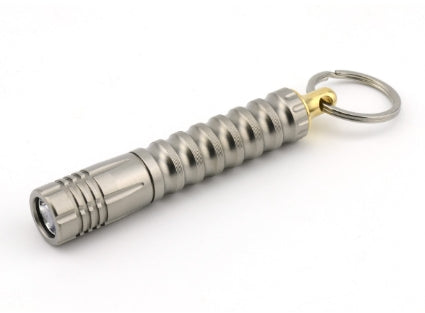Lambda Top Balls Out (Brass & Tungsten)
Tungsten Carbide is the same material CNC cutting inserts are made from and it's incredibly dense and shock resistant.
The real inspiration was making a heavier top (like our Tungsten top) but without having to machine Tungsten. It's not fun. The Balls Out Lambda weighs in at 42.5g, only 1.7g shy of our previous tungsten top. It's also a different sort of headache to machine and assemble. The balls must be coplanar to each other, and perpendicular to the axis of spin within 0.001" .
Everyone is using rubies these days, but we were the first! If you know my work, you know I don't mess around. The Lambda is an expression of how I see the world: the ideal balance of performance, physics, and aesthetics. You are going to have a really hard time finding something is the same size/weight class that will out spin this top.
The Lambda is designed and crafted to be the world's highest precision spin top. When we launched back in 2014, it was also the ONLY precision top in production and spawned an industry. Our design hasn't changed, because it was perfect out of the gate, but we've spent years refining our manufacuring to deliver maximum performance.
Superior Precision: The "solid" variant of the Lambda top is machined from a single piece of solid bar stock. This consumes 4x the amount of material compared to the two-piece tops, but it also delivers a more perfect spin. Any machinist will tell you that the most accurate part is the one machined to completion without removing it from the machine. Any top that is machined on one end, flipped, and machined again is guaranteed to be less accurate. The more times you hold the part, the more error you introduce.
My friend Joe, from Scout Leather Co., had been telling me for months that I should make a top. My response was always, "I make tools, not toys." But I was intrigued. Who doesn't like tops?
One afternoon I had a few hours to play around on the lathe. I had no plan, I was just cutting a top free-hand on the manual lathe. No measurements, no design drawings. Instead of cutting a cone for the tip, I dug around in an old project box and came up with a ruby sphere I bought for another job. The first time I spun the top it was obvious that I created something totally different in performance and physics from anything I had seen before. I showed the prototype to a few people and the most common response was, "Wait, it's still spinning? Are you sure? It doesn't look like it's moving.There is no way it's still spinning." No one else had seen anything like it either. I thought that was pretty awesome, and I believe awesome is worth sharing.
The secret ingredient (beyond a solid design based on Newton and "the physics") is the instrument-grade ruby sphere. You heard me right, I said ruby. This type of manufactured ruby is used in things like Rolex watches, super-precision measuring instruments, fiber optic transmission lines, and other really expensive and/or sciency stuff. The hardness is 9 on the Mohs scale. Diamond is one of the few harder materials and scores a perfect 10. That alone is awesome! This material has five times more abrasion resistance than carbide, zero porosity, high temperature tolerance, extreme chemical resistance, and extreme hardness.
Instrument Ruby is a crystalline form of Aluminum Oxide and called Corundum. Corundum is a naturally occurring mineral, but instrument rubies are synthetic. This material has the distinction of being the very first gem mineral artificially created in a laboratory. A small amount of impurity (Chromium) gives ruby the distinct red color.
So why all the fuss about exotic contact points? Ruby is MUCH harder than stee ball bearingsl, and will spin more efficiently. It's like the difference between ice skating and snow skiing...both water...both fairly "solid" but which one is more efficient for sliding on?
Broken contact balls are not covered under warranty. NEVER drop the Lambda top onto a tile or granite surface or the ball may shatter. Contact points can be replaced in tops that have hollow spindles (all current models)...assuming there isn't other significant damage to the top.
Hazardous Spin Surfaces: A granite (or tile) counter top is MUCH harder than steel. That means if you drop it on a granite or tile counter top there is a significant chance of damaging the instrument ruby. Please remember, this is not a toy, it is a precision instrument and must be treated as such.
Spin Surface Hazards: Glass is fairly soft, and the ruby will probably shatter glass before the ruby breaks. So if you drop your top onto a mirror or a glass table top it will impact with a TINY amount of surface area and magnify the force. I have not personally experienced this, nor have I heard of it happening, but it's still something to keep in mind.
Replacement Balls: You can replace the contact point of any Lambda Top that has a hollow spindle. Balls cannot be replaced on original tops with solid spindles.
8 Minutes: Put in a little practice and 8 minutes can be reached...some of the time. This was the first big milestone. To go past 8 minutes you have to have a good surface...and good technique. At this point I can break 8 minutes almost every time. 10+ Minutes: If you practice a lot, you'll start seeing spins over 10 minutes...but that isvery hard to do. Even now, I might get 1 out of 5 spins that are over 10 minutes. Just keep in mind that trying for a long spin is one way to enjoy your Lambda, but it's not the only way!


* Presentation Box
-
MaterialC360 Brass
-
Weight34.5g
-
Diameter1"
-
Where it's Made















